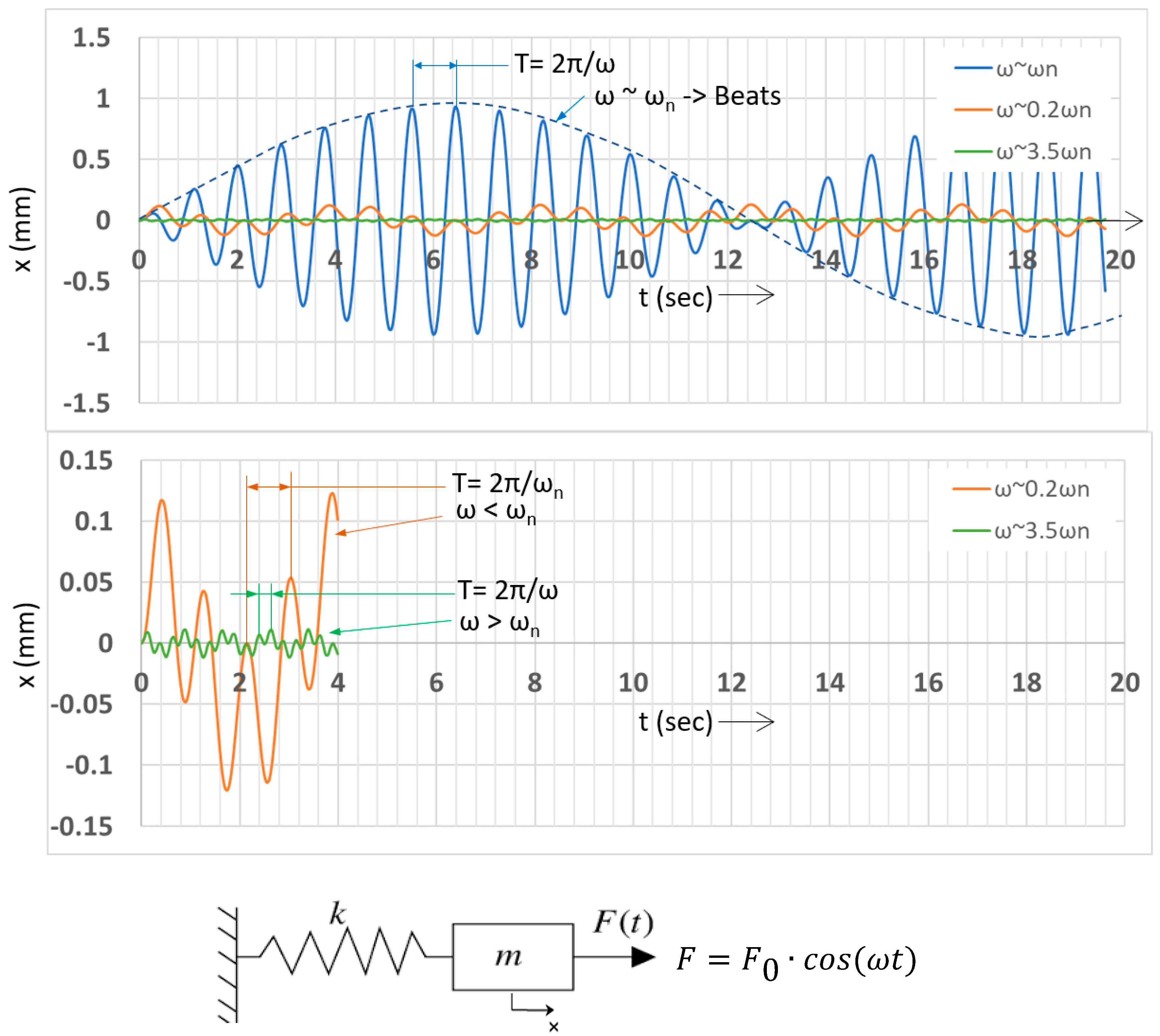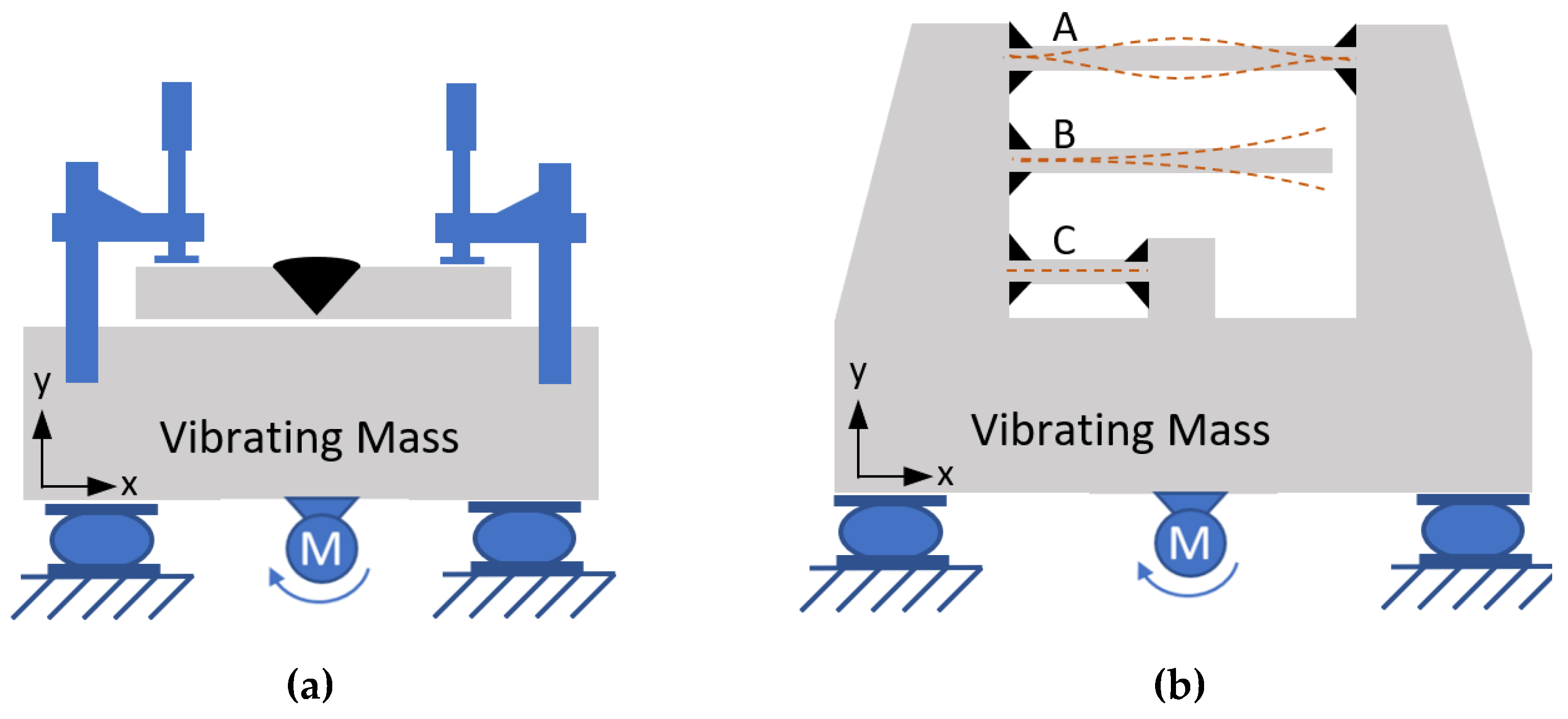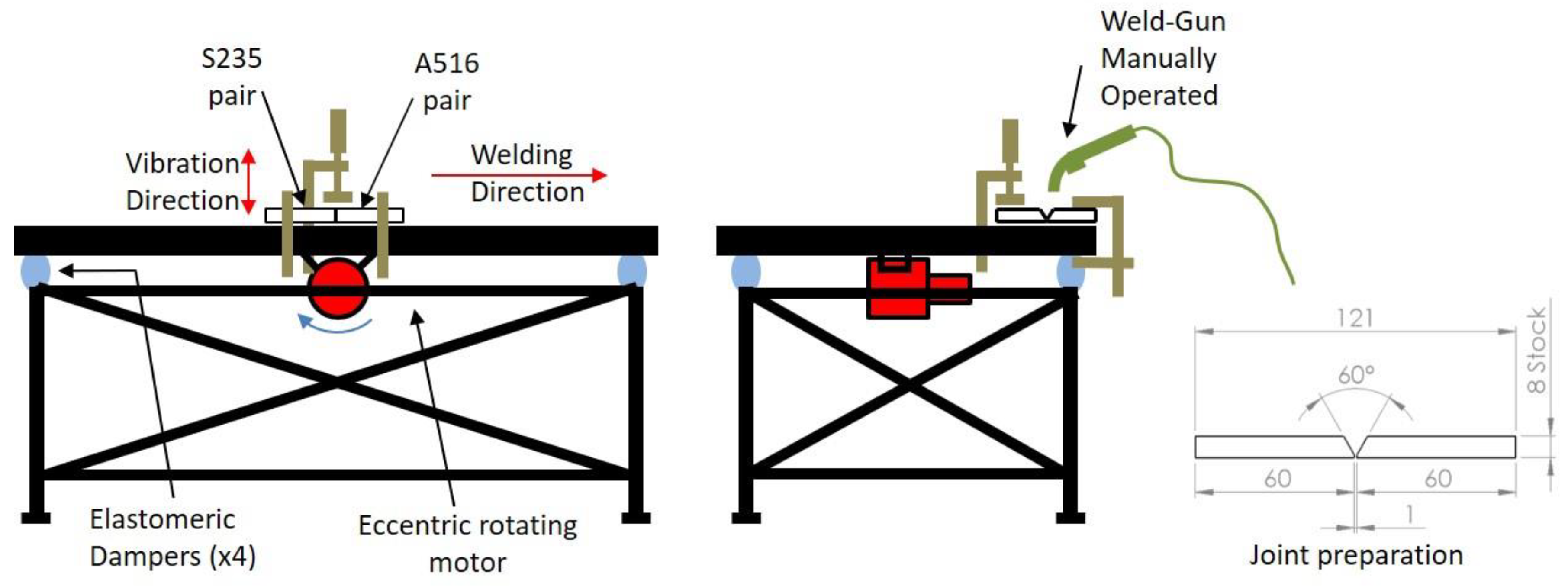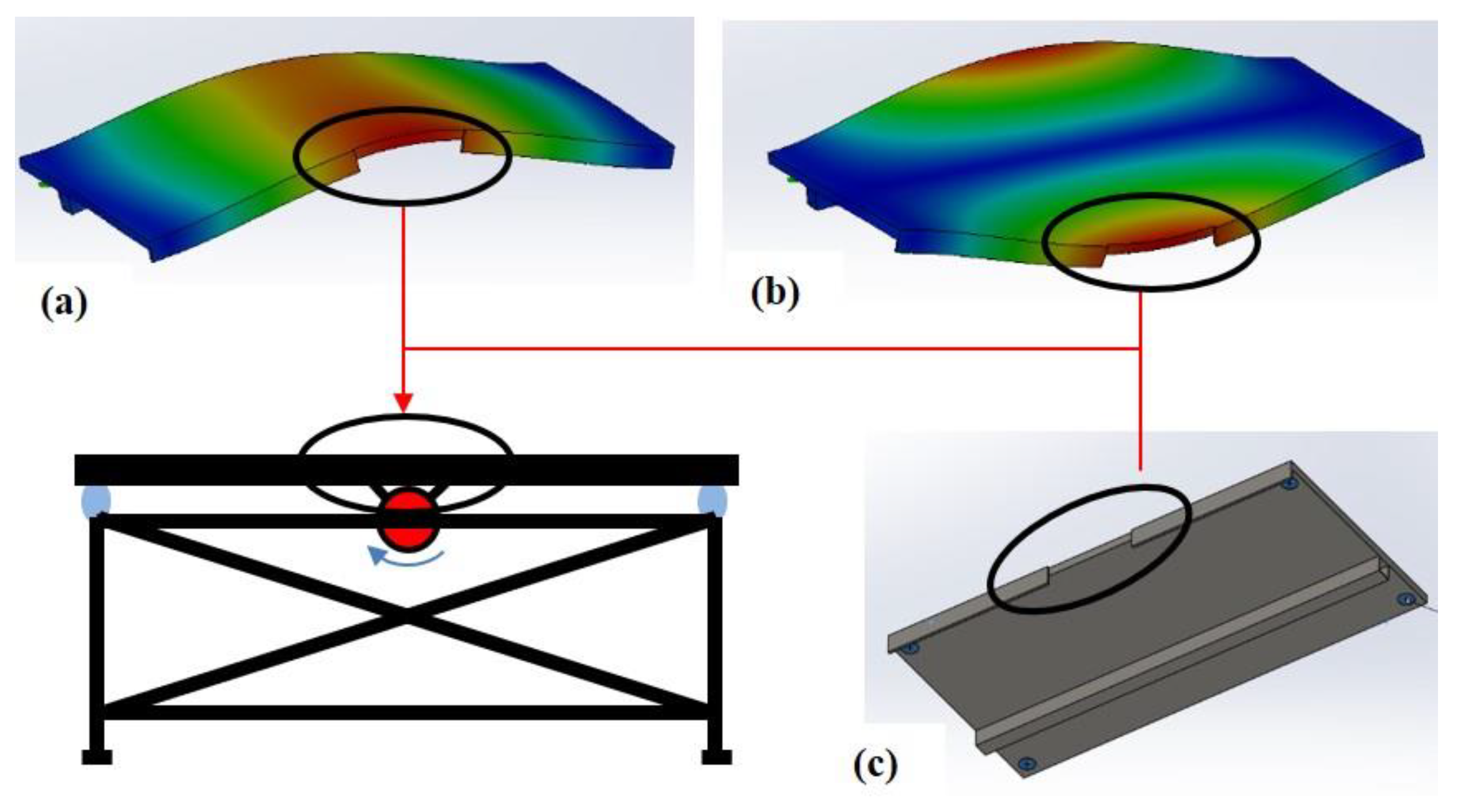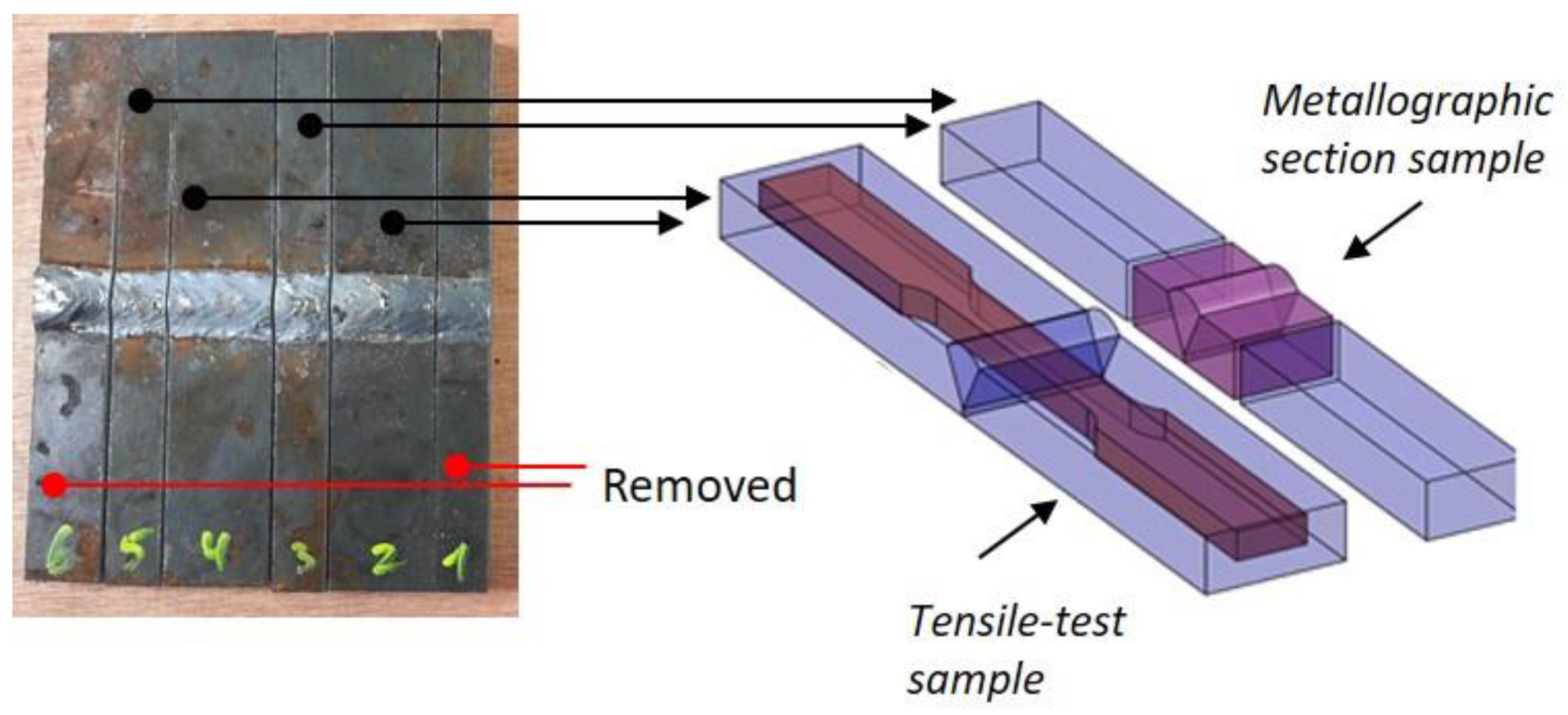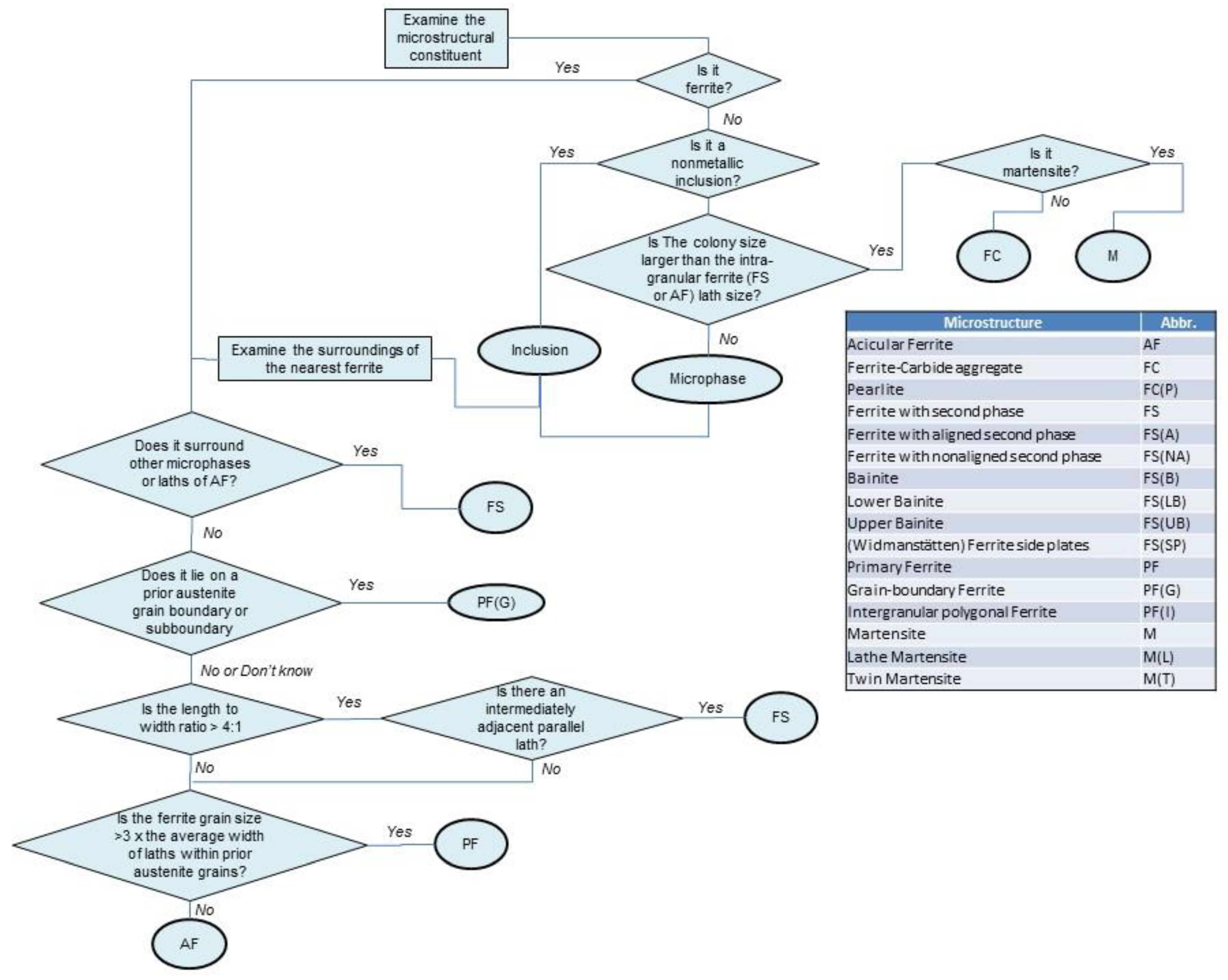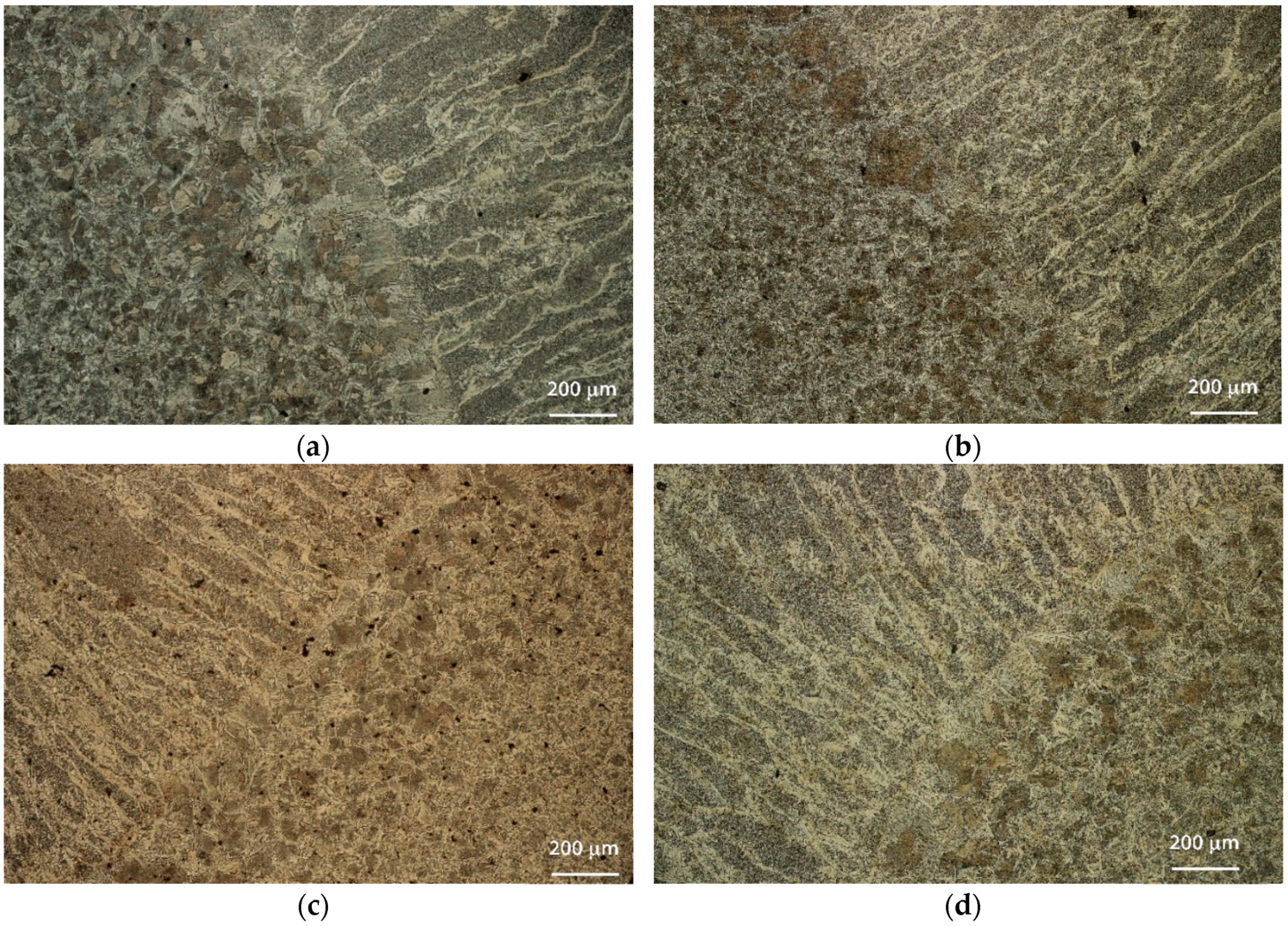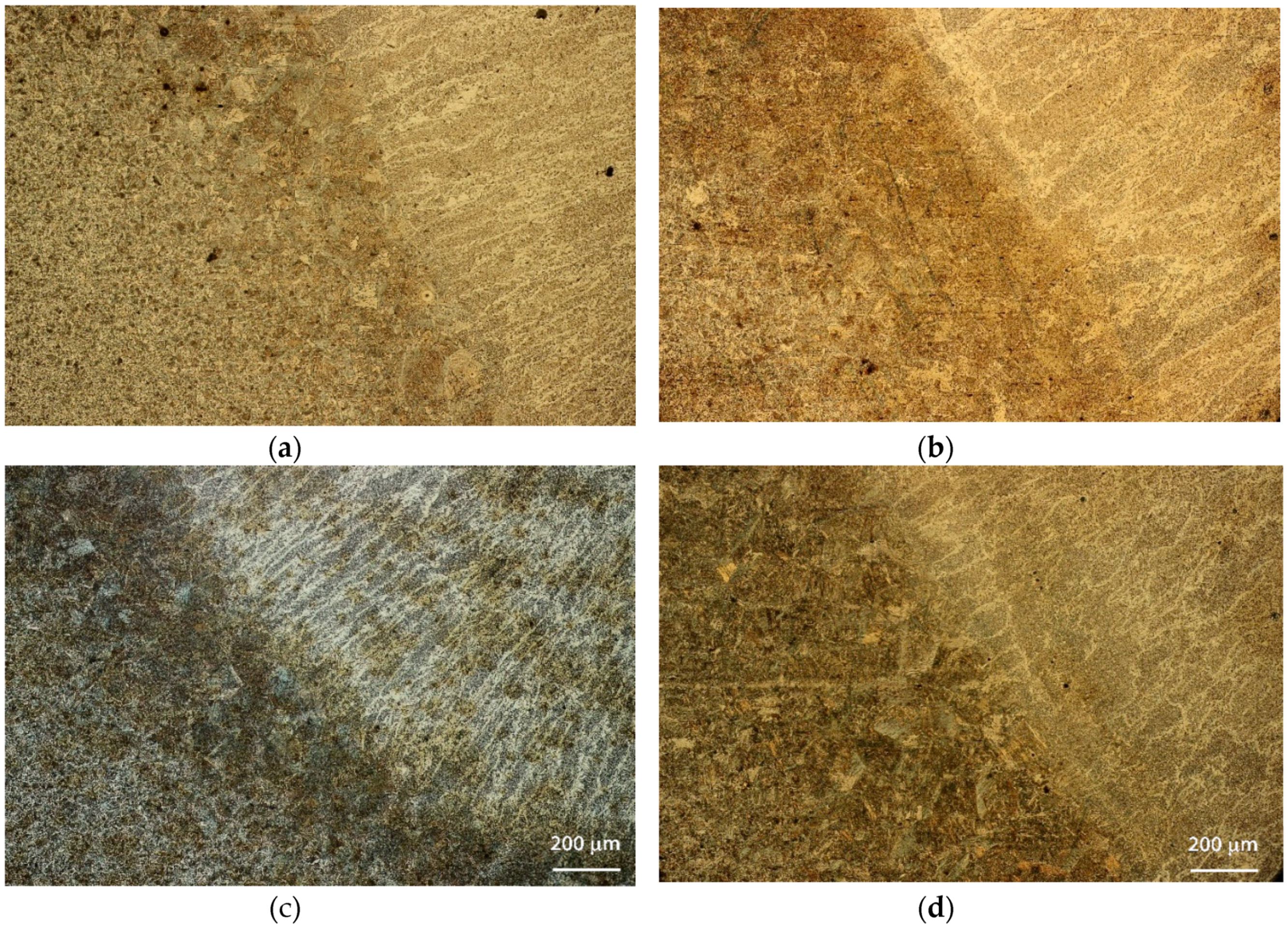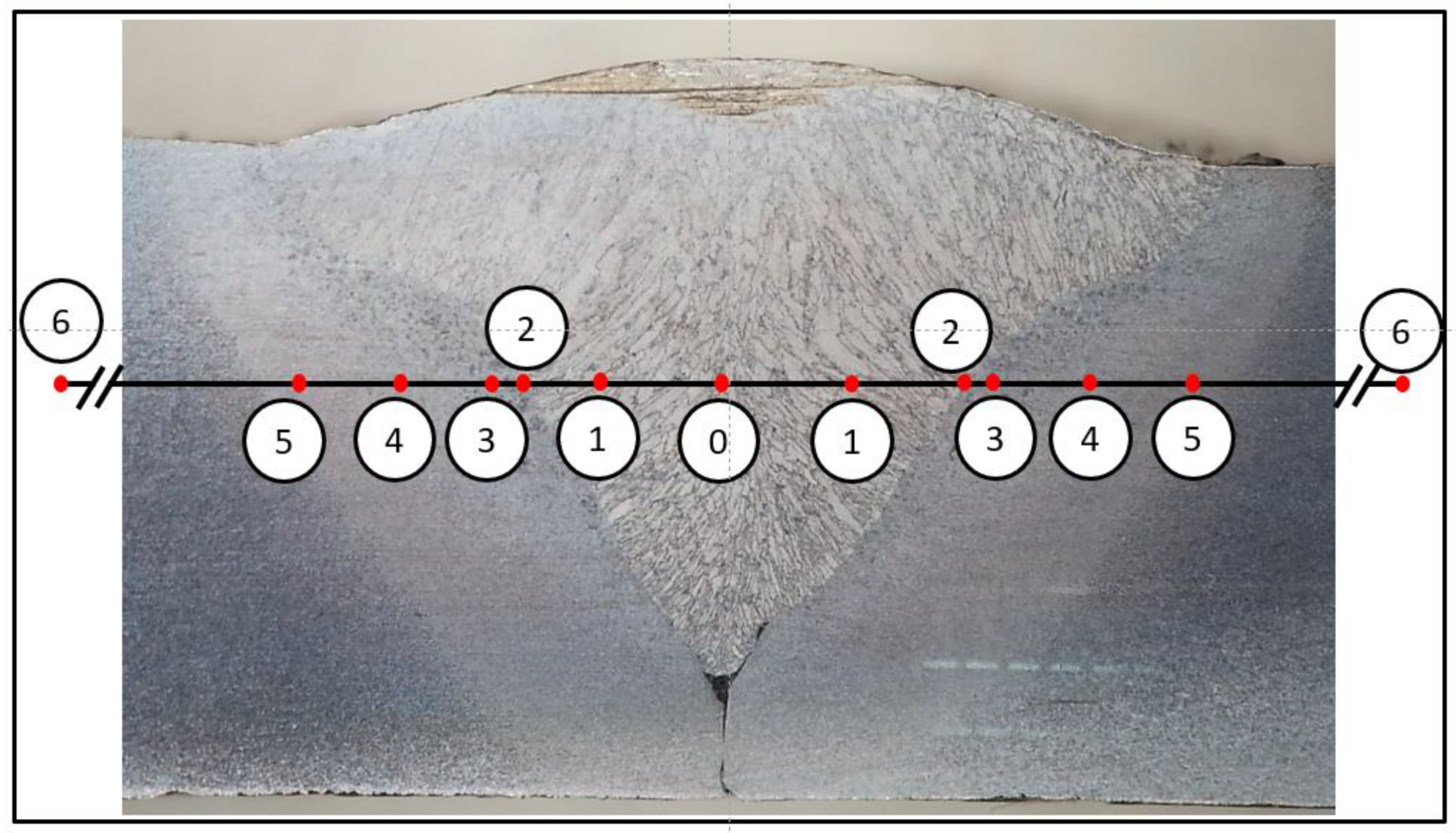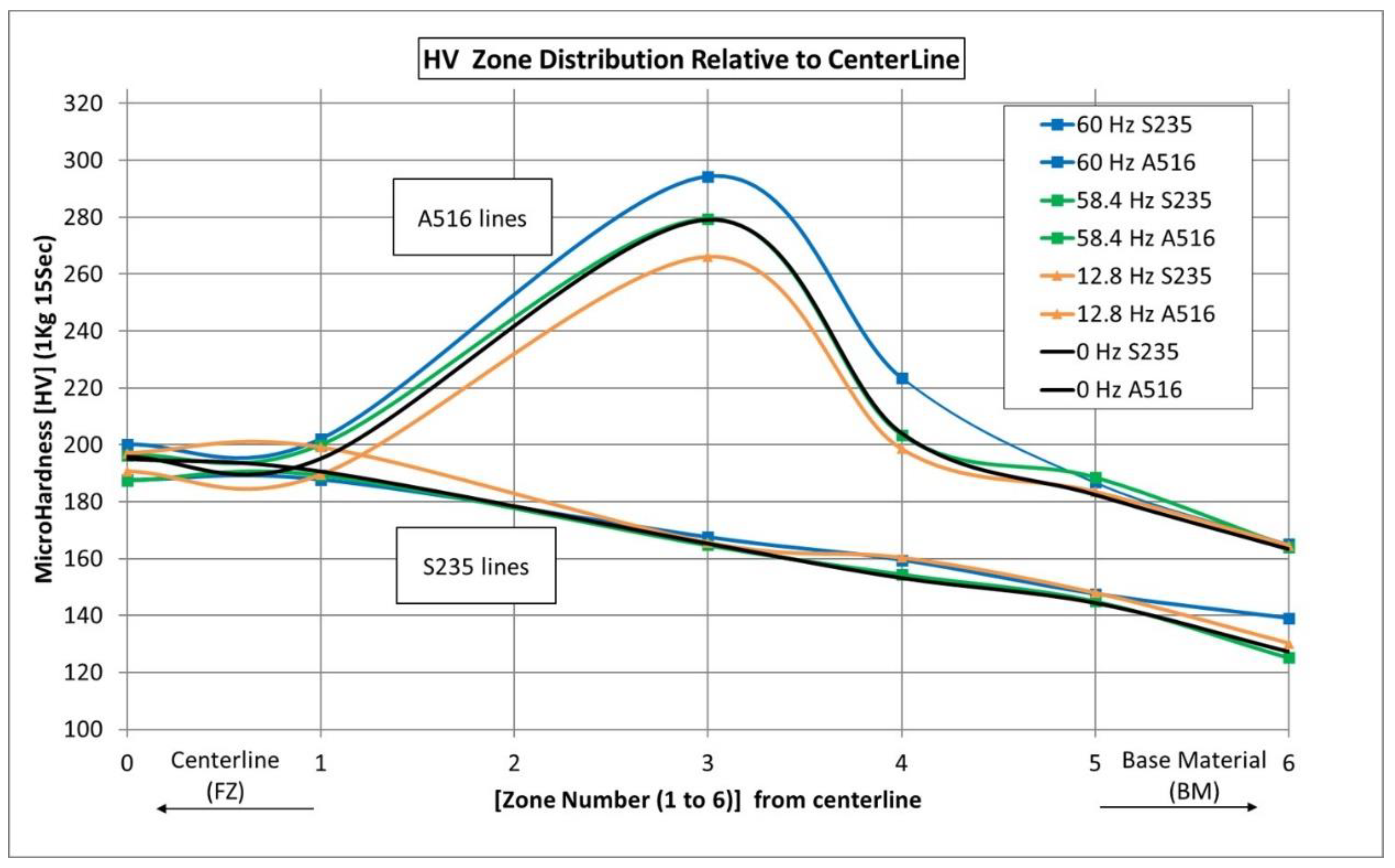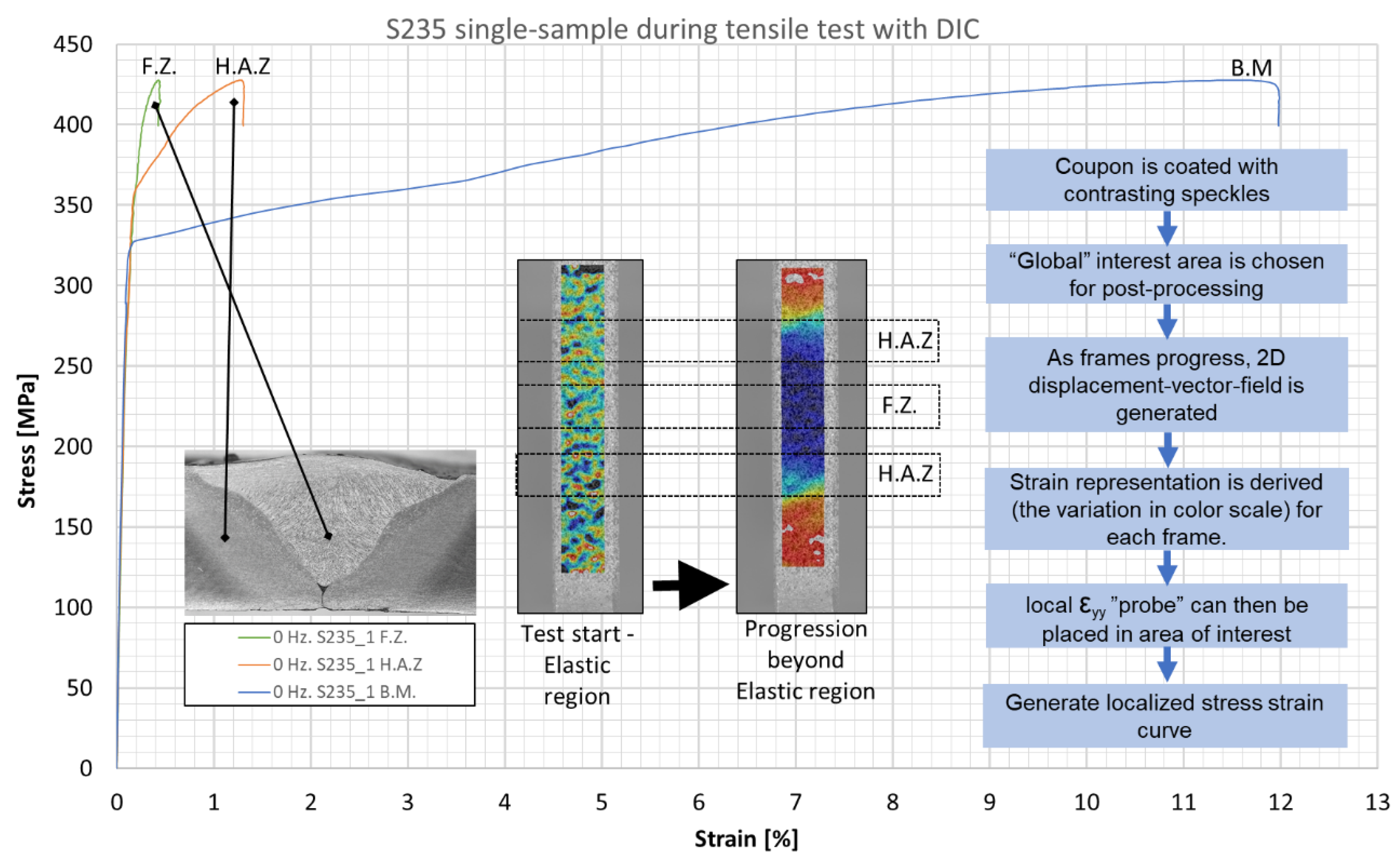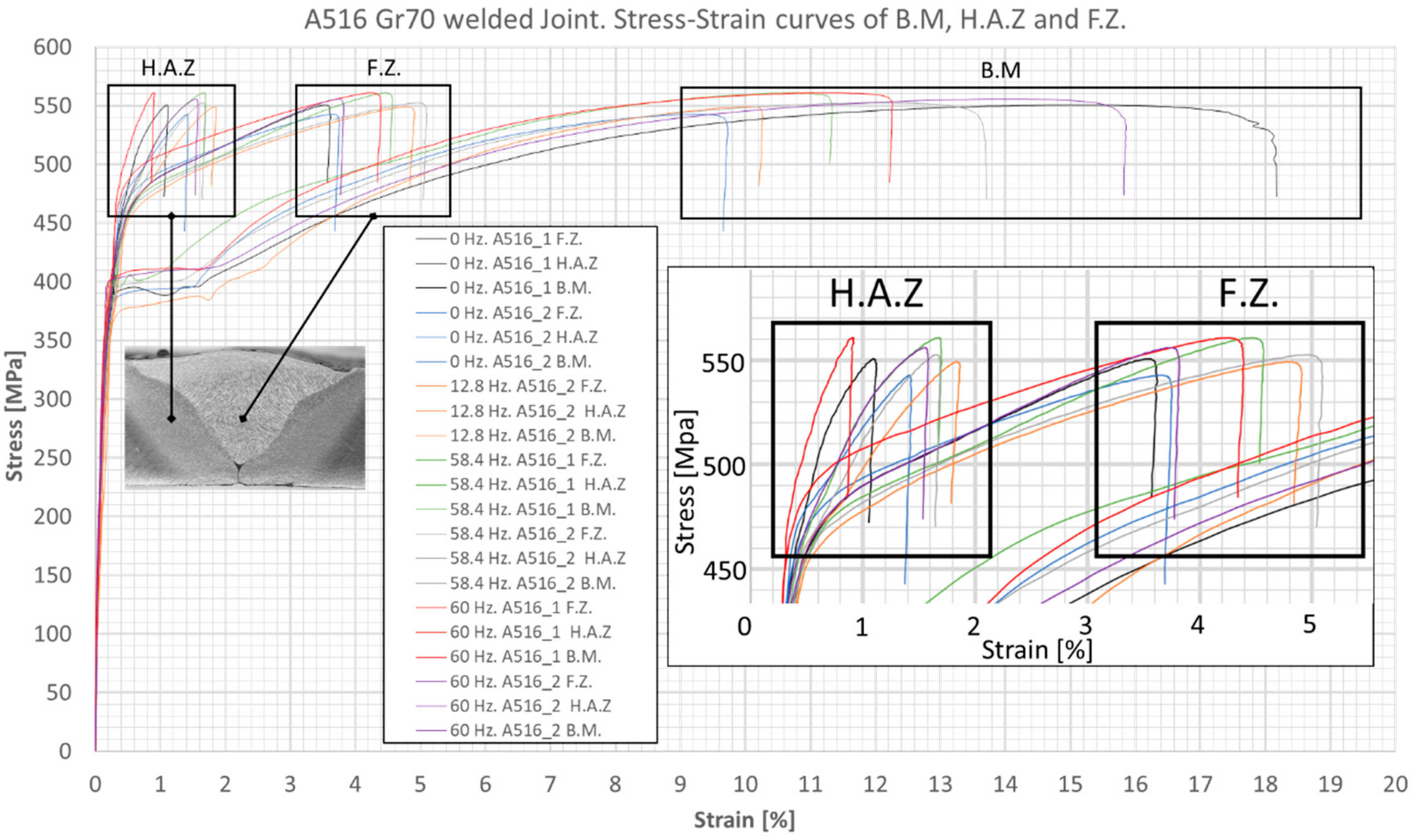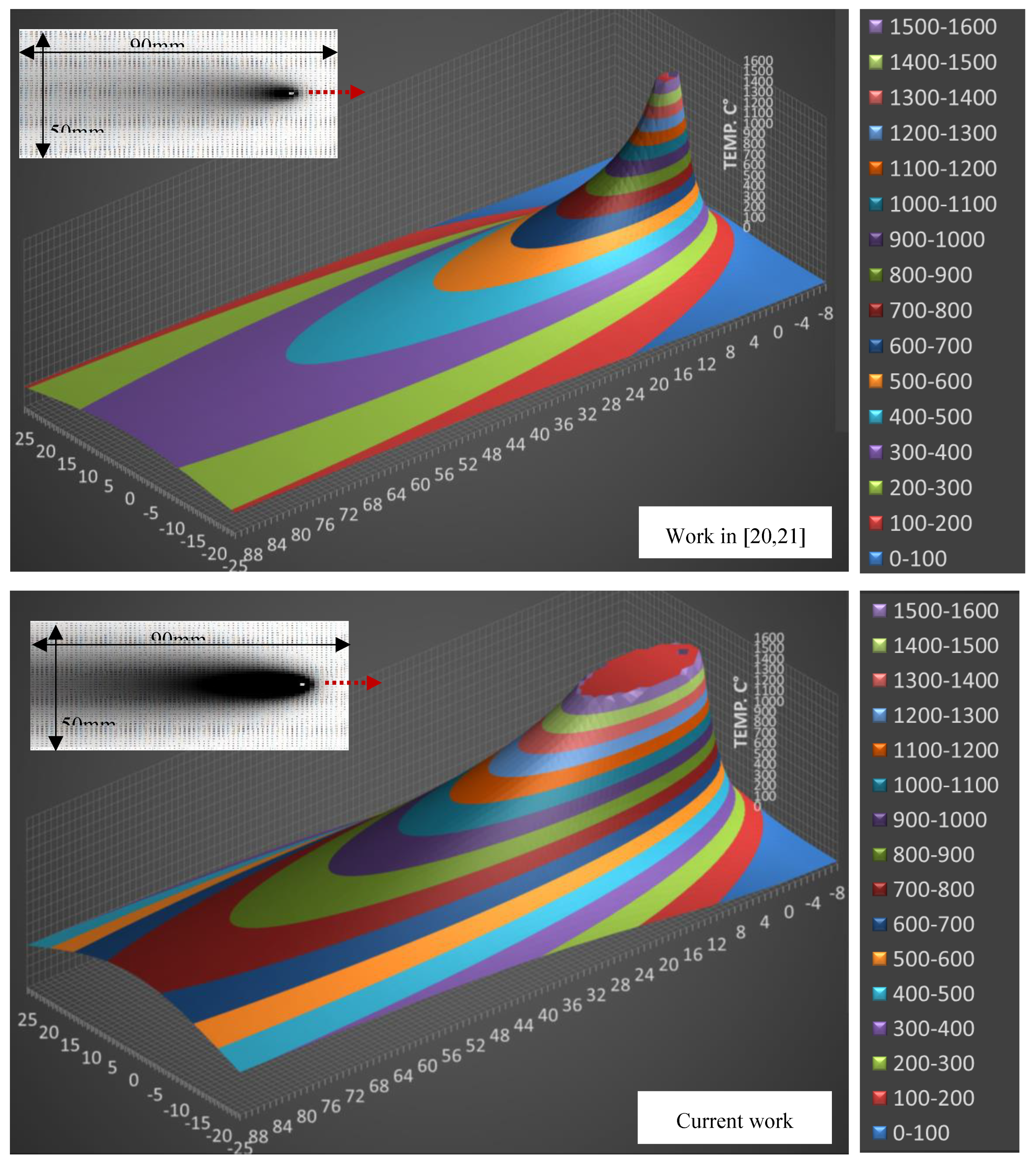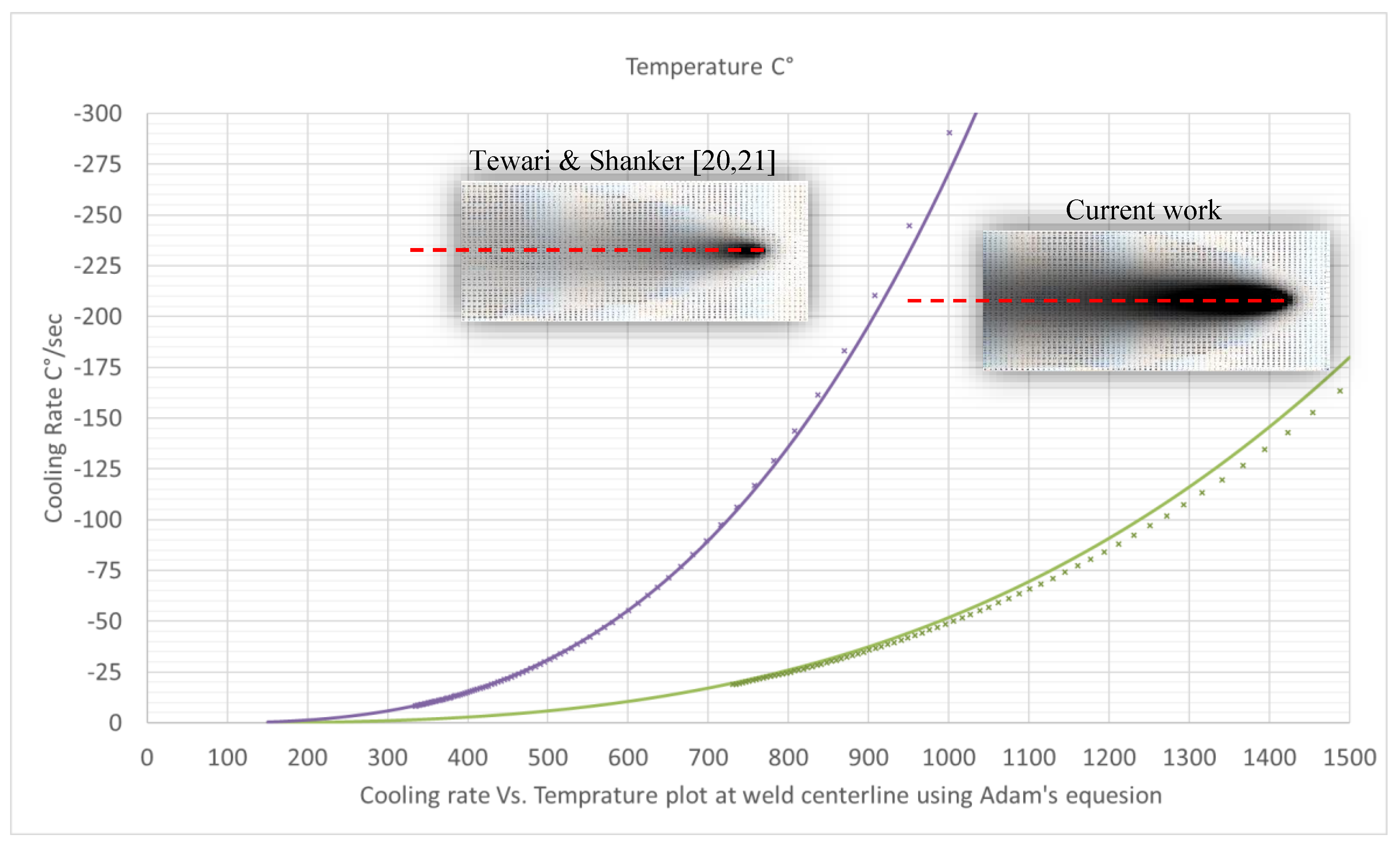1. Introduction
There are many oscillation-involved welding processes, including weld-pool stirring by oscillations of an electromagnetic field or external dipped electrode, ultrasonic agitation of the weld pool via an external transducer, arc oscillations by interchanging electromagnetic field or by oscillating the weld electrode, etc. [
1,
2,
3,
4,
5,
6]. All of these methods have two things in common: (1) The effect on the weld is local, concentrating on vibrating the weld pool as it solidifies with virtually no effect on the surrounding part; (2) these methods require special equipment and cannot be easily implemented with of-the-shelf welding equipment. Therefore, the appeal of a method that uses conventional welding equipment with the addition of only an external vibrator to achieve improvement of weld quality is clear. Results of numerous works have not been consistent enough to yield a “recipe” or a standardized process for producing favorable welds using external vibration. Theoretically, we can induce any pre-defined combination of vibration parameters (e.g., frequency and amplitude in a certain direction) to a welded joint. However, in reality, when attempting to vibrate structures of complex geometry weighing between tens of kilograms and several tons, it is practically impossible to induce a rigid-body-motion vibration in a desired pre-defined frequency/amplitude/direction due to the vibrator physical size, power limitations, and the effect of the structural response.
The underlying principle of commercial vibrators for welding purposes, as well as for vibratory stress relief (VSR) applications, is that with relatively portable equipment of a reasonable size, it is possible to harmonically excite the structure at resonant or near-resonant frequencies to produce relatively large displacements. This excitation of the structure has a dual effect on the weld, depending on the joined parts. Let us distinguish between local (micro) and global (macro) effects of vibration acting on the vibrated welded joint as part of a structure, assuming all other welding variables are constant.
Local vibration effects (LVEs) are the effects that the vibrational parameters (e.g., acceleration, frequency, direction) have on the solidifying molten weld pool as it propagates along the path of the weld line. In other words, it is the rigid-body-motion vibration of the localized weld pool and heat-affected zone (HAZ). An example of LVE setup is shown in
Figure 1a. The local effects may influence the diffusion rate, heat convection rate, and temperature gradient at the boundaries of the melt pool caused by the vibrational stirring of the liquid and shear stresses applied on the liquid (or semi-liquid) by the translating/vibrating base-metal walls, which are also affected by the joint preparation geometry. This case is similar in its geometrical boundary conditions to vibrational castings (but not in terms of heat transfer).
Global vibrational effects (GVEs) are the effects that the weld joint experiences while it is connected to a vibrating structure. These global effects due to structural response occur for any real part with finite rigidity. A schematic example of a setup that allows for GVE is shown in
Figure 1b. Parts “A”, “B” and “C” will experience these GVEs depending on their stiffness ratio. These parts of the structure will experience both LVEs and GVEs, and the vibrating members will induce interchanging tension-compression stresses in the joint. These stresses may exceed the yield strength, especially when the base material is heated due to the welding operation and the yield strength is low. This means that weld solidification and HAZ cooling take place under interchanging stresses.
From an empirical perspective, in order to conclude which parameters induce a change in weld properties, it is crucial to break this coupling of GVE and LVE and examine the effects separately.
The objective of this work is to examine the effectiveness of low-frequency vibration in rigid-body-motion mode (LVE) in producing mechanical and/or microstructural change in structural steel welds. This is achieved by an experimental setup that ensures only LVE of the weld, without flexural motion of the joint (GVE), and by implementing vibrational welding at several frequencies and amplitudes for comparison.
2. Materials and Methods
Two common structural plates of steel were selected: EN 10025 S235JR and ASTM A516 Gr70. These materials were selected due to their widespread use in industry for manufacturing of steel structures.
Samples of 60 × 120 × 8 mm plates were welded using AWS A5.18 ER70S6 ø1 mm solid wire with a single-V groove joint preparation. Pairs of the same steel were welded by gas metal arc welding (GMAW) with shielding gas of 80%Ar–20%CO
2 in a single-pass weld to avoid thermal effects typical of multi-pass welds. For each frequency, two plate mates were welded consecutively in the same pass. The welding speed was calculated by timing the weld pass duration and dividing it by the length of the adjoined plates. Welding was performed on a special welding table, designed for vibratory welding and consisting of a thick plate mounted on four elastomeric pads with an eccentric motor fixed to the bottom of the table, as shown in
Figure 2. The vibratory system used was a PPAW 5500 Meta-Lax/Bonal system (Royal Oak, MI, USA).
The vibration of the plate (or any other geometry) can produce stagnant spatial areas that do not translate, depending on the mode of vibration. In order to ensure definitive local translation regardless of frequency, a preliminary frequency analysis was performed. A 3D computer aided design (CAD) model of the welding table was prepared. Frequency analysis using finite element analysis (FEA) was performed with four elastomeric fixtures at the plate’s corners. Based on these qualitative results, the specific location for test coupon placement was determined, in an area that vibrates throughout the first few modes of vibration, as shown in
Figure 3.
The table was vibrated while measuring its vibrations. A metal cube with two fixed accelerometers (100 mV/g Endevco 41A (Sunnyvale, CA, USA) was fixed to the table surface at the location of the welded samples. The accelerometers were connected to a National Instruments data acquisition system (Austin, TX, USA) with 24-bit resolution over ± 50 g input using a sampling rate of 500 samples per second. The system was excited with shock responses (hammer strike) on each axis as well as continuous variable excitation in order to map its resonant frequency and find the frequencies that induce maximal amplitudes at the specific measured location. The frequencies and amplitudes obtained by the structural response as well as the welding parameters are summarized in
Table 1.
The samples were trimmed at the edges to remove transient effects of the start and endpoints of the welding seam. Each sample was transversely cut to strips, to produce tensile-test specimens and metallographic cross-sections (
Figure 4). Metallographic cross-sections revealing the base metal (BM), HAZ and fusion zone (FZ) were mechanically ground and polished and etched using 3% Nital according to ASTM E407-07. The etched samples were examined under a light microscope (Nikon Eclipse MA200, Tokyo, Japan) and a low-vacuum scanning electron microscope (LV-SEM, Tescan Vega-3LM, Brno-Kohoutovice, Czech Republic) equipped with an Oxford energy-dispersive X-ray spectrometer (EDS) for elemental analysis. Vickers microhardness measurements were conducted on the same metallurgical cross-sections according to ASTM E384-02, using a FutureTech FM-700e machine (Kawasaki-City, Japan) and applying a load of 1 kgf for 15 s.
Specimens for tension tests with digital image correlation (DIC) were machined to ASTM E8-11 sub-size specimens. The samples were coated with contrasting speckles and tested in an INSTRON 5582 machine (Norwood, IL, USA) to which a LaVision system with Elite-2M camera (Göttingen, Germany) and Fujinon FH-25-HA (Minato-ku, Japan) lens was attached for DIC. The tests were conducted at a strain rate of 2 mm/min, a frame rate of 1 fps, and a calibrated resolution of 29.516 μm/pixel. DIC post-processing was done using DaVis 8.2.0 software package.
4. Discussion
In the case of a simple forced vibration by deterministic harmonic excitation of a discrete linear system with a single degree of freedom (DOF), the output is a deterministic harmonic response. The relations between the structural properties and the excitation magnitude and frequency reveal interesting phenomena, as shown in
Appendix A. In reality, the case of forced vibration of a continuous linear system (e.g., a structure with infinite degrees of freedom) by deterministic harmonic excitation is much more complicated and depends on structure geometry, material, location of the exciter, fixtures, type and shape of supporting dampers, etc. Different locations along the structure will vibrate with different characteristics and experience different alternating stresses in the process. Many publications on vibration-assisted welding refer to the exciting frequency as the main “input” parameter in addition to the resonant frequency. Knowing that the resonance frequency (natural 1st mode) of a certain structure is mainly a function of its geometry, the classification of the vibratory regime in relation to the weld as “resonant” or “sub-resonant” seems irrelevant. The local weld joint experiences a certain vibrational characteristic, whether it is a small weld coupon or a weld that is part of a big structure.
Residual stresses in welded structures are the cause of structural deformations and are often examined in works dealing with vibrational welding, since they are measurable (using the hole-drilling method, for example). The reduction of residual stresses is often mistakenly attributed to vibration. Whether vibration is induced during welding or post-welding (as in the case of VSR), the stress relief is not a direct result of the LVE, but rather a byproduct of the structural response that yields plastic deformations around the weld areas, thus achieving stress relief. This has been supported by References [
9,
10,
11,
12,
13,
14] and few cycles are enough, as demonstrated in References [
11,
15,
16] and the experimental setups for GVE [
10,
14,
15]. In the case of simultaneous vibration and welding, the weld area is further heated, which causes the yield strength to drop significantly, implying that under the same strain magnitude, the material will be more prone to plastic deformation. In most cases of real structures, unless a displacement-controlled mechanism is used, exciting the structure at a near-resonant frequency is the only means to produce large local strains using a small vibrator.
Differentiation between vibration as a root cause for various phenomena and vibration as a facilitator of translations/deformations (LVE vs. GVE) must be taken into account in the experimental procedures and analytical approaches to the study of vibrational welding. Overlooking it might be the origin of some confusion regarding the “optimum” conditions (e.g., of frequency, amplitude, and direction) for producing better welds with vibratory welding. For example, in Reference [
17,
18,
19], a large pipe-like structure was welded during vibration at 54–59 Hz. The reduction of residual stresses and structural deformation was reported. Based on the geometrical dimensions of the pipe provided in these articles, a 3D model of the pipe was constructed and a simple frequency analysis using FEA was conducted. The analysis showed that the 1st-mode resonant frequency was 58.8 Hz, which was very close to the frequency used in the experiment, implying that GVE may have been the cause for stress reduction via momentary plastic deformations.
Of the numerous articles reviewed that suggest a critical distinction between LVE and GVE, as explained before, only one work with LVE has shown substantial improvement in the mechanical properties of the weld [
20,
21]. The weld, in that case, was vibrated at higher frequencies (80–400 Hz) than those in the current work, and amplitudes were in the range of 5–40 µm. The results showed an increase in microhardness and tensile strength as the frequency increased.
In order to better understand what other factors (if any) might cause such different results, a comparative simulation of the temperature field of both works was run using Rosenthal’s equation, as shown in
Figure 14. This equation along with the parameters used for solving it are given in
Appendix A. Rosenthal’s equation, though conceived with simplifying assumptions, is a simple and powerful tool for qualitative visualization of the heat flow around the advancing weld. As can be seen in
Figure 14, the thermal regime of the two welds was quite different. Using the same equation and plotting the cooling rates as a function of the momentary temperature along the weld centerline yields (
Figure 15), it was clear that the weld in Reference [
20,
21] had steeper temperature gradients and higher cooling rates than those in the current work. Cooling rates within the temperature range of 800–500 °C, are about 5 to 6 times greater than those in the current work.
This comparison does not explain the different results of the two works. It does, however, emphasize the fact that there are other essential variables that need to be considered when trying to explain results simply by comparing frequency and amplitude in works involving vibrational welding. From this qualitative analysis, two points emerge: (1) A threshold frequency value may exist, at which no apparent effect occurs. The current work employed the low-frequency range of 12–60 Hz, whereas in Reference [
20,
21], was in the range of 80–400 Hz. (2) A threshold cooling rate magnitude (i.e., a slow cooling rate) may exist, under which no apparent effect is apparent regardless of vibration parameters. The current work involves cooling rates of 26 to 6 °C/s at temperatures of 800 °C to 500 °C, respectively. In comparison, the cooling rates in Reference [
20,
21] were 133 to 32 °C/s at temperatures of 800 °C to 500 °C, respectively.
As discussed before, the conditions for producing a favorable weld using vibratory welding are not yet concluded. Therefore, future empirical work should concentrate on finding the combination of frequency/amplitude/direction at which favorable reproducible results can be achieved with respect to LVE. If such a combination is found, it will then be possible to use vibrational control systems to impose such conditions on structural joints from an industrial perspective. From an analytical perspective, on the other hand, it may serve as a validation tool for a comprehensive model of solidification under vibratory conditions.
